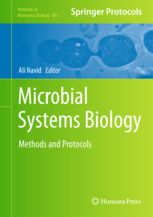Description
Microbial systems biology: methods and protocols (Methods in molecular biology, Vol. 881)
Author: NAVID Ali
Language: English
Subjects for Microbial systems biology: methods and protocols...:
Publication date: 05-2012
702 p. · Hardback
702 p. · Hardback
Description
/li>Contents
/li>
Systems biology is the study of interactions between assorted components of biological systems with the aim of acquiring new insights into how organisms function and respond to different stimuli. Although more and more efforts are being directed toward examining systems biology in complex multi-cellular organisms, the bulk of system-level analyses conducted to date have focused on the biology of microbes. In, Microbial Systems Biology: Methods and Protocols expert researchers in the field describe the utility and attributes of different tools (both experimental and computational) that are used for studying microbial systems. Written in the highly successful Methods in Molecular Biology series format, chapters include introductions to their respective topics, lists of the necessary materials and reagents, step-by-step, readily reproducible laboratory protocols, and key tips on troubleshooting and avoiding known pitfalls. Authoritative and practical, Microbial Systems Biology: Methods and Protocols introduces and aids scientists in using the various tools that are currently available for analysis, modification and utilization of microbial organisms.
Part I: Sample Prepartion and Identification. Flow Cytometry in Environmental Microbiology: A Rapid Approach for the Isolation of Single-Cells for Advanced Molecular Biology Analysis. Pressure Cycling Technology in Systems Biology. Targeted Isolation of Proteins from Natural Microbial Communities Living in an Extreme Environment. Bacterial Identification and Subtyping Using DNA Microarray and DNA Sequencing. Part II: Experimental Genomic Analyses. Genetic Manipulation of the Obligate Chemolithoautotrophic Bacterium Thiobacillus denitrificans. Genome-wide Mapping of the Binding Sites of Proteins that Interact with DNA. Part III: Protein and Lipid Analyses. Microbial proteomics using mass spectrometry. Fourier Transform Infrared Spectroscopy for Molecular Analysis of Microbial Cells. Part IV: Metabolomic Analyses. Mass Spectrometry-based Microbial Metabolomics. Fast Sampling of the Cellular Metabolome. Part V: Analyses of Cellular Metabolism. Metabolic Pathway Determination and Flux Analysis in Non-model Microorganisms through 13C-isotope Labeling. Biology Phenotype Microarrays. NanoSIP: NanoSIMS Applications for Microbial Biology. Part VI: Kinetic Modeling of Cellular Processes. Electrophysiological-metabolic Modeling of Microbes: Applications in Fuel Cells and Environment Analysis. Simulating Microbial Systems: Addressing Model Uncertainty/Incompleteness via Multiscale and Entropy Methods. Part VII: Genome-Scale Computational Studies. Bacterial Genome Annotation. LeishCyc: a Guide to Building a Metabolic Pathway Database and the Visualization of Metabolic Data. Development of Constraint-base System-level Models of Microbial Metabolism. Complex Network Analysis in Microbial Systems: Theory and Examples. Modeling a Minimal Cell.
© 2024 LAVOISIER S.A.S.




